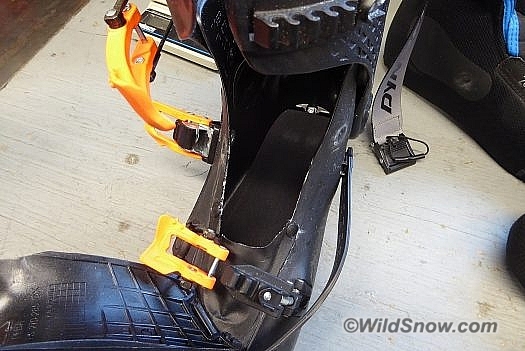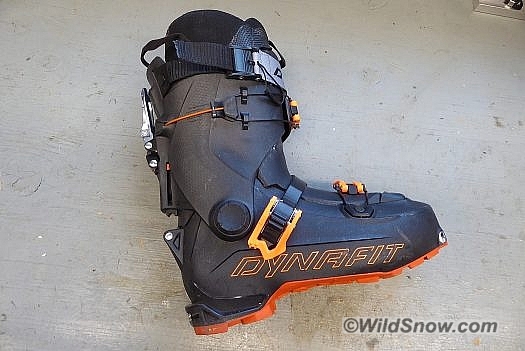This post sponsored by our publishing partner Cripple Creek Backcountry.
“I design out of laziness. I want a ski boot that doesn’t require pulling my pants up and struggling with latches and buckles,” says Fritz Barthel as he stands on one leg like a ballet dancer (or, a stork?), hands free, and kicks down the lean-lock lever of his Hoji Pro boot. He smiles and says “Nice,” then glides a few meters away to check our descent route, leaving me enjoying the view of my unbuckled (insert brand-model here) ski boots.
As I found during my past year of testing the Hoji Pro, Barthel’s ideal can be realized.
Whoops, I almost forgot the eponymous Hoji, who designed the boot in partnership with Fritz. His goal was a touring boot that skied down better than most touring boots. Best of all worlds? The easily operated boot that’s light and skis downhill okay? In that we still have a winner.

I submit to the lasting obsession many of you readers have. It’s possible to measure last width using the heat-molded liner, which usually matches the inside of the boot. Left, Hoji liner from my 27.5 measures 102 millimeters, while the TLT-6 liner to right, also 27.5, measures 98 millimeters and is noticeably lower volume.
First, fit. Dynafit claims Hoji has a 103.5 millimeter last. I’ll testify that the boot is indeed on the wide side — but only at the metatarsal. The heel pocket width is average to tight, and the instep is low. I’m a skinny-heeled guy with a skiing problem, and the Hoji holds my heels down like a little troll grabbing my calcaneus with his horny hands. Being fully weaponized with my heat gun and boot press, I forced the troll back to his lair. The wide toe box is fine for me. But those of you who like a boot that pinches your foot might need a careful evaluation as to whether Hoji is your destiny. Operative point: Most skiers will not need punches in the forefoot area — you might not need that $200.00 boot fitting contract.

I’ve got an average to high instep. Trimming a few millimeters of plastic from the sides of the opening did the trick.
(I still maintain that a clamp-like feel can be achieved through boot fitting techniques, but doing so can be a time waster. More, other boot fitters claim doing so never gets the results of using a narrower shell. Take that as you will.)
Let’s get to the gripes so I can move on to more goodness.
Worst thing has to be the power strap. It’s just, well, old school. The same strap I found innovative several years ago is now a fiddly effing fiddle that belies the overall convenience of the Hoji design philosophy. Why? Simply because the thing is too short, and too hard to thread and un-thread. The strap has a cap on the end that catches in the buckle when you need full release, and makes it hard to thread when you’re gearing up. Even before I cut the cap off, the strap was too short for a good grip, two more centimeters would be good — that after shedding the infernal end-cap. Overall impression: The power strap is perhaps the exception that proves the rule. That rule being that everything else with this boot is cutting-edge — except for one more feature that’s nothing less than weird. That being the “Speed Nose” toe shape.
You can call something “Speed” until you your vocal chords fail, and it doesn’t make it so. Yes, Virginia, the Speed Nose does move the tech fittings a few millimeters aft. Makes ergonomic sense. But “sense” doesn’t necessarily translate to real life. The theory is greater than the effect. And the Speed schnoz itself? Travel and forget your crampons; borrow some you can easily fit? Not gonna happen. Depend on binding with “locator” feature at the toe that’s configured for a standard DIN shaped toe? Not gonna help. Kick steps in hard snow? Not the same. Hire skis with a toe-wing type binding? Nope. Sadly, next season’s Hoji Pro will continue with the Spreed Nose (that is not a typo). Saving grace is the Hoji Free model will go back to the conventional toe, so you can consider that shoe if the weird toe is a deal breaker. One thing I’ll give the Spreed Nose: It does look distinctive, it gets people thinking I’ve taken up snowboarding.
(To be fair, Dynafit sells a crampon, the Cramp-In, specifically for the Speed Nose boots. The Cramp-In is light and interesting in how it attaches to a hook you screw to your boot sole. But I’m not convinced it’s a versatile or reliable solution. Likewise, Dynafit at one time sold an adapter that ostensibly worked with regular “automatic” crampons, but this product appears to be discontinued — I don’t see it in their 2019-2020 product workbook.)
With that off my chest I’d better close with the positive, otherwise Hoji will make me huck a cliff.
Once you figure out your Hoji Pro adjustments, you truly can start the day with your buckles in one position, and switch between up and down modes with one motion. In the case of descent, you kick the lean-lock lever down (as Fritz demonstrated at the start of this article). For the climb, pull the lever up with your hand.
I found the down-kick easy to learn, but it requires leaving your pants tucked behind the upward oriented lever so it’s exposed. That looks odd and can be the precursor to your cuff riding high and letting snow in. (Perhaps Dynafit will design pants that work with this?) Grabbing the lever with your hand and pulling for uphill mode is intuitive — similar to most other boots with an external lean lock. I found the lever difficult to grab with gloves, it could use a bigger lip or perhaps a cord grip-loop.
Before you get too starry eyed about the “one motion,” know that achieving satisfactory feel during both uphill and down requires a fitted boot. Otherwise you’ll probably be tweaking a few buckle settings and your power strap as you change modes. Likewise, I found that long-flat tours still asked for a loosened upper buckle and power strap.
It’s worth mentioning the improved position of the Hoji instep buckle. Many skiers have found the middle (instep) buckle of most Dynafit boots to be slightly forward of the optimal position. Hoji brings it back to the ergonomic position, as close to your instep as possible.
Hoji has Dynafit’s Master Step tech fittings. That’s important regarding the heel fitting, as it’s stronger than the original style. While I prefer the original style toe fittings, or Quick Step In (which the Hoji Free version of this boot will have), that’s just me, so ignore and let’s call this all a plus.
I’ve not abused the Hoji, but I’ve used them enough to ID any obvious durability problems. No cracks, no cuff pivot wear, buckles have not snapped. Pass.
Lastly, and most importantly, this boot skis beautifully. The Hoji Lock system does what it promises: a firm “locked” feel with little to none of the odious cuff bulge many other boots present. And yes, it does have a somewhat “progressive” flex. Though not the perfected feel of a well designed overlap cuff boot, you’ll like it.
I never have one go-to boot during a season, that’s my job. But if any member of my scaffo harem is the favorite, Hoji is it.
(For those of you who care about weight, my Hojis with foot beds and mods weigh 1,536 grams each. I’d like them to be closer to the one kilo ideal, but they work for my messed up feet, so I’ll shut up.)
WildSnow.com publisher emeritus and founder Lou (Louis Dawson) has a 50+ years career in climbing, backcountry skiing and ski mountaineering. He was the first person in history to ski down all 54 Colorado 14,000-foot peaks, has authored numerous books about about backcountry skiing, and has skied from the summit of Denali in Alaska, North America’s highest mountain.

